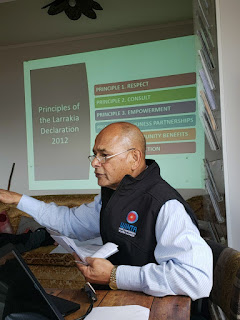By Kara Passey, final year MDP student
 |
| Early leaders gathered in Puvirnituq for a joint
meeting with the Fédération des Co opératives du Nouveau-Québec (FCNQ) in 1979. |
The 1844 Rochdale co-op in England is
usually credited as the first co-operative business, consisting of 28 men who
were skilled weavers and labourers. Many more co-ops followed suit, formed in
resistance to a job market which was increasingly taking advantage of its
workers (ex. long working hours - sometimes 16 hour days with no breaks, low
wages, unsanitary and unsafe working conditions, etc). The increased interest
in co-op development is also thanks to the formation of the International Co-operative
Alliance (ICA). Formed in 1895 by E. V. Neale and Edward Owen Greening, ICA is
an NGO which serves the interests of co-op development, and works as both an
advocate for co-ops, and also as an educator for communities who are
considering future co-op development. Neale and Greening were also responsible
for penning the 7 co-op principles which are still well circulated today, and
took their inspiration from the original Rochdale co-op.
1. Voluntary and Open Membership - Cooperatives are voluntary organisations,
open to all persons able to use their services and willing to accept the
responsibilities of membership, without gender, social, racial, political or
religious discrimination.
2. Democratic Member Control - Cooperatives are democratic organisations
controlled by their members, who actively participate in setting their policies
and making decisions. Elected representatives are accountable to the members.
Members typically each have one vote worth the same value, as opposed to
corporations whose voting power lay in stock ownership.
3. Member Economic Participation - Members contribute equitably to, and
democratically control, the capital of their cooperative. Members allocate
surpluses for any or all of the following purposes: developing their cooperative,
possibly by setting up reserves, part of which at least would be indivisible;
benefiting members in proportion to their transactions with the cooperative;
and supporting other activities approved by the membership.
4. Autonomy and Independence - Cooperatives are autonomous, self-help
organisations controlled by their members. If they enter into agreements with
other organisations, including governments, or raise capital from external
sources, they do so on terms that ensure democratic control by their members
and maintain their cooperative autonomy.
5. Education, Training, and Information - Cooperatives provide education and training
for their members, elected representatives, managers, and employees so they can
contribute effectively to the development of their co-operatives. They inform
the general public - particularly young people and opinion leaders - about the
nature and benefits of co-operation.
6. Cooperation among Cooperatives - Cooperatives serve their members most
effectively and strengthen the cooperative movement by working together through
local, national, regional and international structures.
7. Concern for Community - Cooperatives work for the sustainable
development of their communities through policies approved by their members.
Principles retrieved from:
https://www.ica.coop/en/cooperatives/cooperative-identity
When the European fur market crashed, and
Hudson Bay Trading posts closed down in the Arctic, Inuit were left unable to
return to their traditional, sustainable way of life, and unable to access the
commodities from the south that they had grown to depend on. Populations of
Inuit were starving and fully dependent on government subsidies and allowances,
and there was pressure to strategize how to generate income in these remote
communities, and reestablish Inuit access to southern goods. The Department of
Northern Affairs and National Resources began to encourage the development of
co-operative businesses, which was an approach welcomed by Inuit because it
encouraged their self-determination and sovereignty, and because the co-op
principles (particularly that of working together for the common good) aligned
so well with Inuit principles.
While specific elements of Inuit culture
vary based on region and community (such as language or dialect, cosmology,
specific types of art materials or aesthetic), the core principles of Inuit
knowledge resonate across communities. The government of Nunavut established a
set of Inuit Societal Values, also known as piqujat (communal laws), that they
use to guide their work, particularly when determining policy and approaches to
development. They are briefly summarized below:
● Inuuqatigiitsiarniq:
Respecting others, relationships and caring for people
● Tunnganarniq:
Fostering good spirits by being open, welcoming and inclusive
● Pijitsirniq:
Serving and providing for family and/or community
● Aajiiqatigiinniq:
Decision making through discussion and consensus
● Pilimmaksarniq/Pijariuqsarniq:
Development of skills through observation, mentoring, practice, and effort
● Piliriqatigiinniq/Ikajuqtigiinniq:
Working together for a common cause
● Qanuqtuurniq:
Being innovative and resourceful
● Avatittinnik
Kamatsiarniq: Respect and care for the land, animals and the environment
(Government of Nunavut, n.d.)
The purpose of formally establishing these
principles was not so Inuit could hold tight onto their own ways - in fact,
adaptability and resourcefulness have guided Inuit through thousands of years
of life. These principles instead work as a guiding reminder that what is
important to Inuit does not always resonate with what is important to
non-Inuit. They encompass an intersecting point between environmental knowledge,
societal values, cosmology worldviews, and language. Since the co-op principles
ensure and inspire member inclusivity, consensus building,
innovation, opportunities for learning and growth, and planning for the future,
it was easy for Inuit to see how this approach was not only beneficial but
culturally appropriate for their communities.















